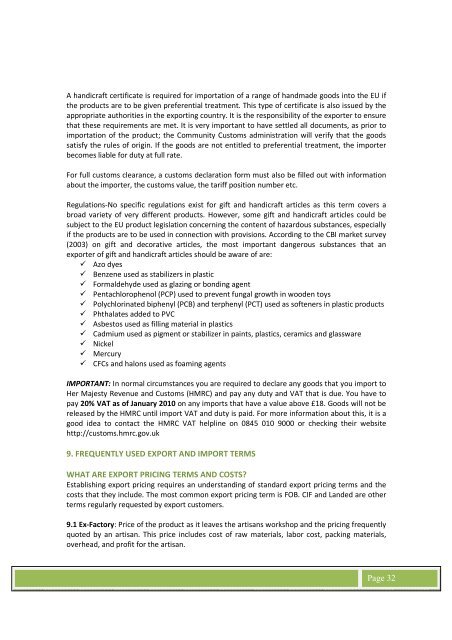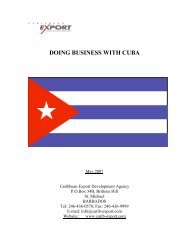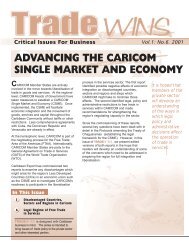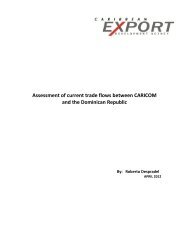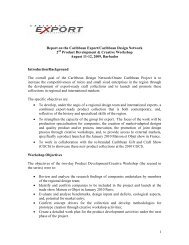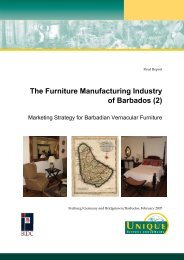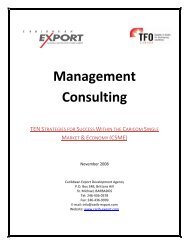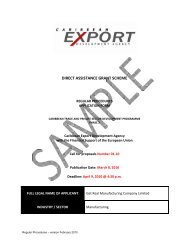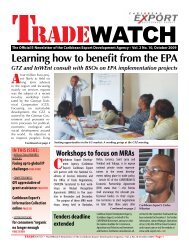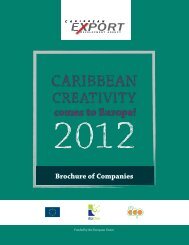Market Access Manual for Artisans Rev2 - Caribbean Export ...
Market Access Manual for Artisans Rev2 - Caribbean Export ...
Market Access Manual for Artisans Rev2 - Caribbean Export ...
You also want an ePaper? Increase the reach of your titles
YUMPU automatically turns print PDFs into web optimized ePapers that Google loves.
A handicraft certificate is required <strong>for</strong> importation of a range of handmade goods into the EU if<br />
the products are to be given preferential treatment. This type of certificate is also issued by the<br />
appropriate authorities in the exporting country. It is the responsibility of the exporter to ensure<br />
that these requirements are met. It is very important to have settled all documents, as prior to<br />
importation of the product; the Community Customs administration will verify that the goods<br />
satisfy the rules of origin. If the goods are not entitled to preferential treatment, the importer<br />
becomes liable <strong>for</strong> duty at full rate.<br />
For full customs clearance, a customs declaration <strong>for</strong>m must also be filled out with in<strong>for</strong>mation<br />
about the importer, the customs value, the tariff position number etc.<br />
Regulations‐No specific regulations exist <strong>for</strong> gift and handicraft articles as this term covers a<br />
broad variety of very different products. However, some gift and handicraft articles could be<br />
subject to the EU product legislation concerning the content of hazardous substances, especially<br />
if the products are to be used in connection with provisions. According to the CBI market survey<br />
(2003) on gift and decorative articles, the most important dangerous substances that an<br />
exporter of gift and handicraft articles should be aware of are:<br />
� Azo dyes<br />
� Benzene used as stabilizers in plastic<br />
� Formaldehyde used as glazing or bonding agent<br />
� Pentachlorophenol (PCP) used to prevent fungal growth in wooden toys<br />
� Polychlorinated biphenyl (PCB) and terphenyl (PCT) used as softeners in plastic products<br />
� Phthalates added to PVC<br />
� Asbestos used as filling material in plastics<br />
� Cadmium used as pigment or stabilizer in paints, plastics, ceramics and glassware<br />
� Nickel<br />
� Mercury<br />
� CFCs and halons used as foaming agents<br />
IMPORTANT: In normal circumstances you are required to declare any goods that you import to<br />
Her Majesty Revenue and Customs (HMRC) and pay any duty and VAT that is due. You have to<br />
pay 20% VAT as of January 2010 on any imports that have a value above £18. Goods will not be<br />
released by the HMRC until import VAT and duty is paid. For more in<strong>for</strong>mation about this, it is a<br />
good idea to contact the HMRC VAT helpline on 0845 010 9000 or checking their website<br />
http://customs.hmrc.gov.uk<br />
9. FREQUENTLY USED EXPORT AND IMPORT TERMS<br />
WHAT ARE EXPORT PRICING TERMS AND COSTS?<br />
Establishing export pricing requires an understanding of standard export pricing terms and the<br />
costs that they include. The most common export pricing term is FOB. CIF and Landed are other<br />
terms regularly requested by export customers.<br />
9.1 Ex-Factory: Price of the product as it leaves the artisans workshop and the pricing frequently<br />
quoted by an artisan. This price includes cost of raw materials, labor cost, packing materials,<br />
overhead, and profit <strong>for</strong> the artisan.<br />
32<br />
Page 32


